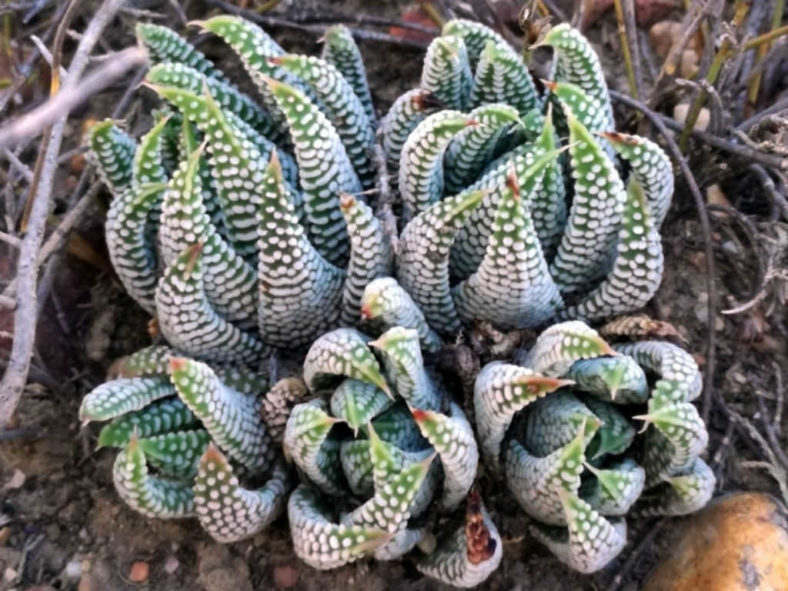Tulista is a small genus of 4 attractive dwarf succulents endemic to the Western Cape province of South Africa. The species were previously included in the genus Haworthia, subgenus Robustipedunculares. They were classified as members of the genus Tulista by Manning et al. in 2014. The type species of the genus is Tulista pumila.
These perennial succulents are relatively slow-growing and have quite a long lifespan, surviving for up to several decades in nature or cultivation. They have small, stemless rosettes of fleshy leaves that are non-fibrous and generally larger than those of Haworthia and Haworthiopsis. The color and texture of leaves vary among the different species and within a species. Tulistas are usually solitary or occasionally suckering from the base to form small clumps. They generally have well-branched inflorescences. Flowers are white or whitish with a pink or brownish-green central vein on the tepals and mostly appear in spring and summer.
The meaning of the generic name "Tulista" is unclear.
Growing Conditions for Tulista
Tulistas are easy to grow if you keep in mind that they are succulents and require the appropriate growing conditions. They are particularly suited for growing in containers. Tulistas can be grown successfully in rockeries in frost-free areas with low winter rainfall.

Light
These succulents tolerate full sun, but they prefer semi-shaded positions. The brighter light conditions are needed to bring out the leaf coloration. Any window in your home or office will likely be an appropriate setting for Tulistas.
Soil
Use commercial soil formulated for succulents or make your own well-draining potting mix.
Temperature
Tulistas like warmer temperatures in the summer but cool in the winter. They can tolerate cold down to USDA hardiness zone 10a, 30 °F (-1.1 °C).
Pot Size
The pot should be shallow, as the root system is not deep. Be sure that it has at least one drain hole.
General Care for Tulista
Tulista care, no matter the species, is easy and minimal.
Watering
When the growth is most active in spring and fall, water Tulistas thoroughly, then wait until the top of the soil dries out before watering again. Water your plants less during the winter when their growth slows down significantly. During the hottest summer months, when Tulistas are mostly dormant, water them just enough to keep the leaves from shriveling. Never allow drops of water to remain for long in the rosettes. If you use saucers, empty any standing water promptly.
Fertilizing
Tulistas do not require much fertilizer. However, for optimum growth, fertilizing is a good idea. Feed during the growing season with a weak fertilizer solution. Do not fertilize during the winter.
Repotting
When it begins to outgrow its pot, repot your Tulista in a new shallow and slightly larger pot with fresh soil. The best time to repot is in the spring or early summer. Repotting time is also the time to take offsets for propagation.
How to Propagate Tulista
Using seeds or offsets are the most frequently used methods of propagating Tulistas.
Seeds
Sow the seeds in spring or fall in a well-draining potting mix and keep the soil slightly moist. Germination usually takes two weeks. Transplant the seedlings into individual pots after the first or second year.
Offsets
Remove offsets when they have started developing their roots. Water sparingly until the plants have rooted and show signs of growth.
Leaves
Unlike Haworthia and Haworthiopsis, these succulents are not as easy to propagate from leaves.
Pests and Diseases of Tulista
Pests
Tulistas are generally free of most pests. The exception is mealybugs, which can be a problem that is easily resolved by physical removal or standard houseplant insecticides.
Diseases
The number one killer of Tulistas is overwatering. Soil that is constantly wet can lead to root rot. Symptoms of a rotted root include the stoppage of growth, reduction in plant or leaf size, or leaf shriveling. Sometimes, root rot will move into the plant stem, resulting in the death of the plant.
Toxicity of Tulista
Tulistas are generally non-toxic to humans and animals.
Links
- Back to genus Tulista
- Succupedia: Browse succulents by Scientific Name, Common Name, Genus, Family, USDA Hardiness Zone, Origin, or cacti by Genus